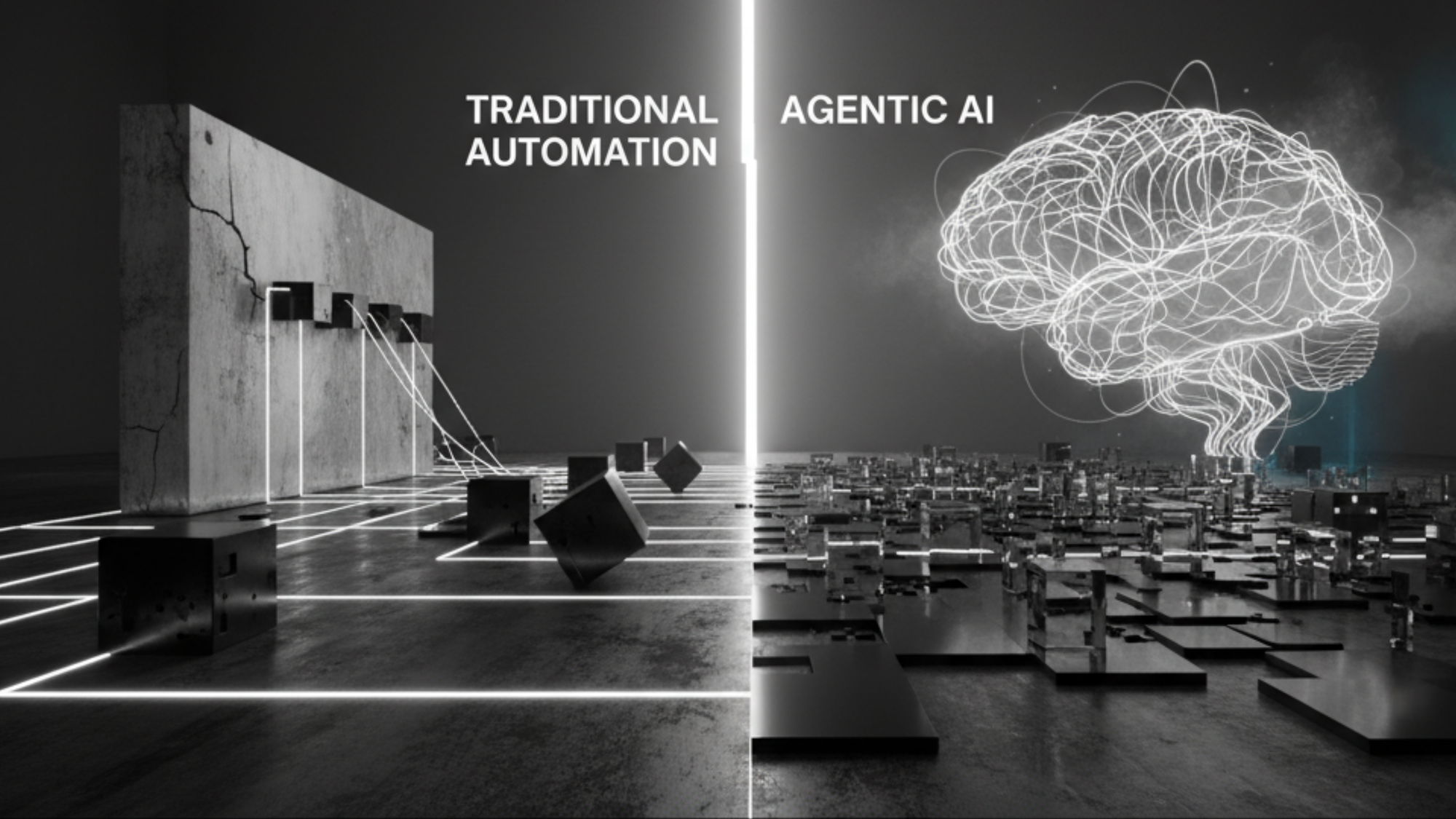
Your company implemented robotic process automation last year. It worked great for the first few months processing invoices, transferring data between systems, and handling routine tasks exactly as programmed.
Then your business process changed slightly. A vendor updated their invoice format. Your automation broke. IT spent two weeks reprogramming everything.
Meanwhile, you're reading about companies using AI agents that adapt to changes automatically, make decisions without human input, and handle complex scenarios your current automation can't touch.
You're wondering: what exactly is Agentic AI, and is it really different from the automation you already have?
According to McKinesy, nearly 8 in 10 companies report using generative AI, yet just as many report no significant bottom-line impact. They call this the "gen AI paradox." Source:- Here
Agentic AI might be the solution to that paradox. But understanding what makes it different from traditional automation is critical before you invest.
What is Agentic AI?
Agentic AI refers to artificial intelligence systems that can autonomously make decisions, take actions, and pursue complex goals with limited human supervision.
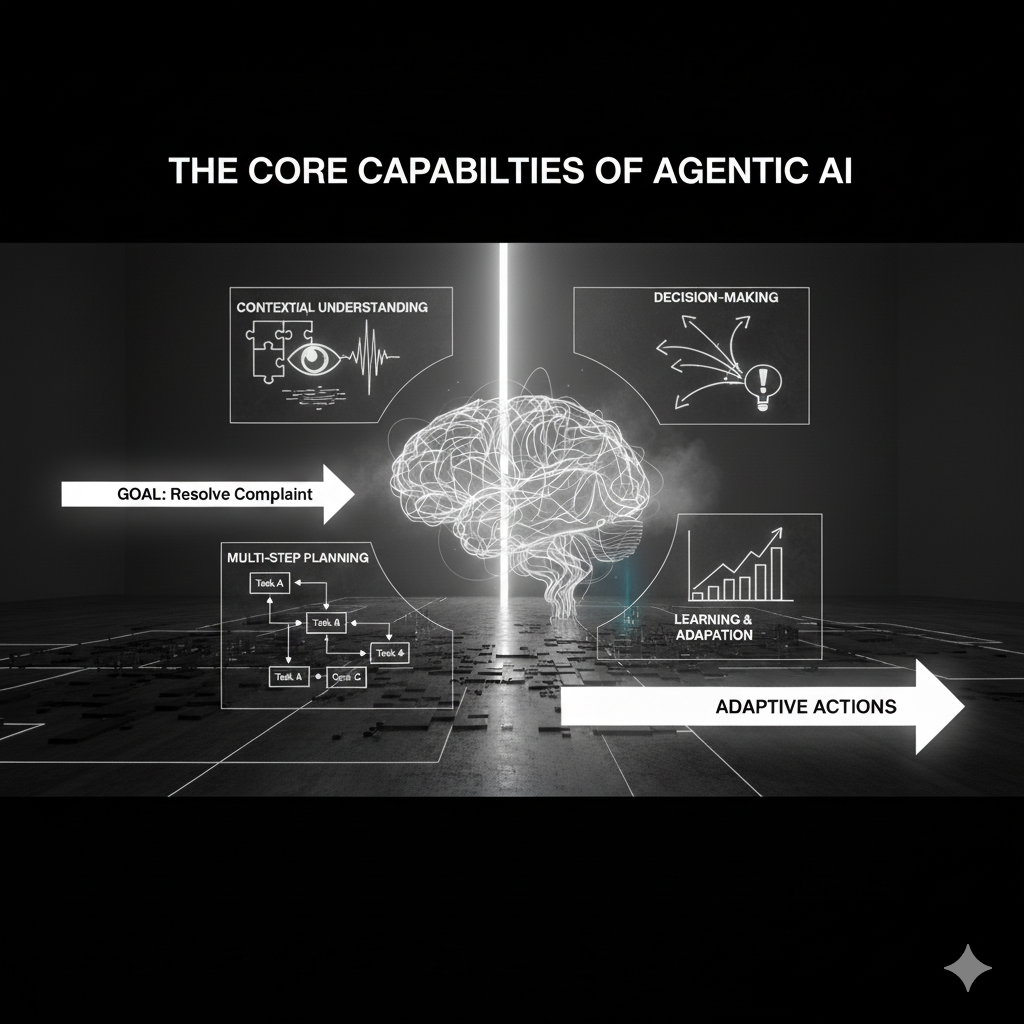
The keyword there is "autonomously." These aren't systems waiting for your instructions. They're AI agents that understand objectives, evaluate situations, make decisions, and act all on their own.
Think of Agentic AI like this: Instead of following a recipe step-by-step, it understands what you want to cook and figures out how to make it happen, even if ingredients are missing or the kitchen layout changes.
The Core Capabilities of Agentic AI
Autonomous AI agents combine several capabilities that traditional systems lack.
- Goal-oriented behavior: You give AI agents objectives, not step-by-step instructions. "Resolve this customer complaint" rather than "If customer says X, respond with Y."
- Contextual understanding: Agentic AI systems understand the situation they're operating in. They read between the lines, recognize patterns, and adjust behavior based on context.
- Decision-making without rules: Instead of following predefined rules, AI agents evaluate options and choose the best path forward based on their understanding of the goal and situation.
- Learning and adaptation: Agentic automation improves over time. These systems learn from outcomes, refine their approaches, and get better at achieving objectives without constant reprogramming.
- Multi-step planning: Autonomous AI agents can break down complex goals into smaller tasks, execute them in the right order, and adjust the plan if something doesn't work.
How Agentic AI Actually Works
Agentic AI typically combines large language models (LLMs) with traditional programming for accuracy and reliability.
The LLM component provides flexible reasoning, natural language understanding, and the ability to handle ambiguous situations. The traditional code provides structure, constraints, and deterministic behavior where precision matters.
AI Agent uses this combination to:
- Perceive their environment (read emails, monitor systems, analyze data).
- Understand what's happening (identify issues).
- Make decisions (evaluate options, predict outcomes, choose actions).
- Take action (execute tasks, communicate with people or systems, trigger workflows).
- Learn from results (remember what worked, adjust future behavior).
This isn't artificial general intelligence. Agentic AI systems operate within defined domains and pursue specific types of goals, but within those boundaries, they exhibit genuine autonomy.
Is Your Automation Breaking Every Time Things Change?
Stop reprogramming your RPA every week. Get AI agents that adapt automatically to process changes.

What is Traditional Automation, and How Does it Work?
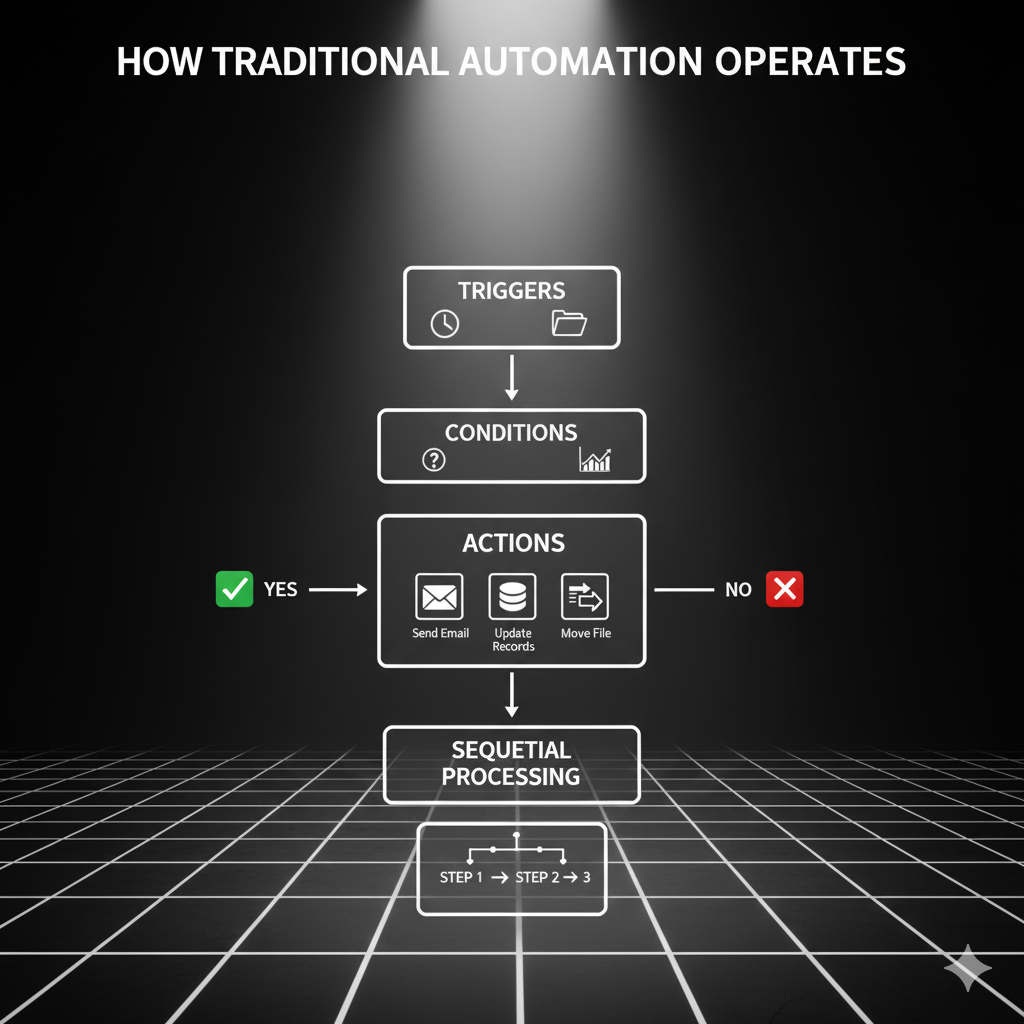
Traditional automation refers to rule-based systems that execute predefined tasks without human involvement. Think robotic process automation (RPA), scheduled scripts, workflow engines, and macros.
These systems follow explicit instructions. If X happens, do Y. When condition A is met, trigger action B. They're deterministic, given the same input, they always produce the same output.
How Traditional Automation Operates
Rule-based automation works through explicit programming:
- Triggers: Something specific starts the automation at a scheduled time, such as a file appearing, a button click, or a form submission.
- Conditions: The system checks predefined conditions. Is this field populated? Does this value exceed a threshold? Is this the right file type?
- Actions: Based on those conditions, the automation executes specific, programmed actions. Move this file. Send that email. Update these records.
- Sequential processing: Traditional automation follows steps in a predetermined order. Step 1, then step 2, then step 3. No deviation.
This approach works beautifully for structured, repetitive tasks in stable environments. Processing payroll, backing up databases, transferring files, and updating inventory are perfect use cases.
Where Traditional Automation Excels
Traditional automation delivers real value in the right situations:
- Predictable processes: When workflows rarely change and inputs are consistent, rule-based automation is reliable and efficient.
- High-volume repetitive tasks: Processing thousands of similar transactions, moving data between systems, generating reports—automation handles these faster than humans.
- Compliance and consistency: Traditional automation executes tasks exactly the same way every time, which matters for regulatory compliance and quality control.
- Low-risk operations: For tasks where errors are easily caught and consequences are minimal, simple automation provides good ROI with low implementation complexity.
The problem comes when you try to apply traditional automation to dynamic, unpredictable, or complex scenarios. That's where the wheels come off.
What are the Key Differences Between Agentic AI and Traditional Automation?
The difference between Agentic AI and traditional automation comes down to how they handle complexity, change, and decision-making.
| Feature | Traditional Automation (RPA, Scripts) | Agentic AI (AI Agents) |
|---|---|---|
| Core Principle | Rule-Following: Executes explicit, predefined, step-by-step instructions. | Goal-Seeking: Pursues high-level objectives and figures out the best way to achieve them. |
| Response to Change | Rigid: Breaks when inputs or business processes change even slightly; requires immediate, costly reprogramming. | Flexible/Adaptive: Adapts in real-time to new data formats, system updates, and unforeseen variations. |
| Data Handling | Structured Data: Requires predictable inputs like CSVs, fixed forms, and consistent API formats. | Unstructured Data: Easily handles messy, real-world inputs like emails, complex documents, chat, images, and audio. |
| Decision-Making | Deterministic: Follows a fixed set of rules (*If X, then Y*); fails if a situation isn't covered. | Contextual & Judgment-Based: Evaluates options and makes decisions based on the goal, even in novel situations. |
| Process Flow | Sequential: Follows a predetermined order (Step 1, then 2, then 3); stops or errors if a step fails. | Adaptive Planning: Breaks down goals, executes tasks in parallel, and dynamically adjusts the plan if an attempt fails. |
| Maintenance | High Maintenance: Requires constant manual updates, rule modification, and reprogramming for every edge case. | Low Maintenance: Learns and improves over time from outcomes, requiring fewer updates for minor environmental changes. |
Flexibility vs Rigidity
Traditional automation breaks when things change. New invoice format? Automation breaks. Website redesign? Your web scraper stops working. Business process update? Everything needs reprogramming.
Agentic AI adapts to change. If the invoice format changes, AI agents recognize it's still an invoice and extract the relevant information. They don't need reprogramming for every minor variation.
Rule-Following vs Goal-Seeking
Rule-based automation follows explicit instructions. It does what you programmed, nothing more, nothing less. If a situation isn't covered by your rules, the automation fails or does something inappropriate.
AI agents pursue objectives. Tell them to "ensure customer satisfaction" and they'll figure out appropriate actions based on the specific situation—even situations you never anticipated or programmed for.
Structured Data vs Unstructured Data
Traditional automation needs structured, predictable inputs. CSV files with consistent columns. Forms with predefined fields. API responses in expected formats.
Agentic AI systems handle unstructured data. Natural language emails. Complex documents. Images and audio. They extract meaning from messy, real-world inputs that would break traditional automation.
Sequential vs Adaptive Processing
Traditional automation follows predetermined sequences. Step A, then step B, then step C. If step B fails, the whole process usually stops or produces errors.
Agentic automation adapts its approach dynamically. If one method doesn't work, AI agents try alternatives. They can skip unnecessary steps, execute tasks in parallel, or completely rethink their approach based on what's happening.
Maintenance Requirements
Rule-based automation requires constant maintenance. Every business process change, every system update, every new edge case requires someone to modify the automation rules.
AI agents need less maintenance because they adapt automatically. You might need to adjust their goals or constraints, but you don't reprogram them for every minor environmental change.
Why is Agentic AI Becoming Essential in 2025?
The shift toward Agentic AI isn't just hype. Real business pressures are making autonomous, adaptive systems necessary rather than optional.
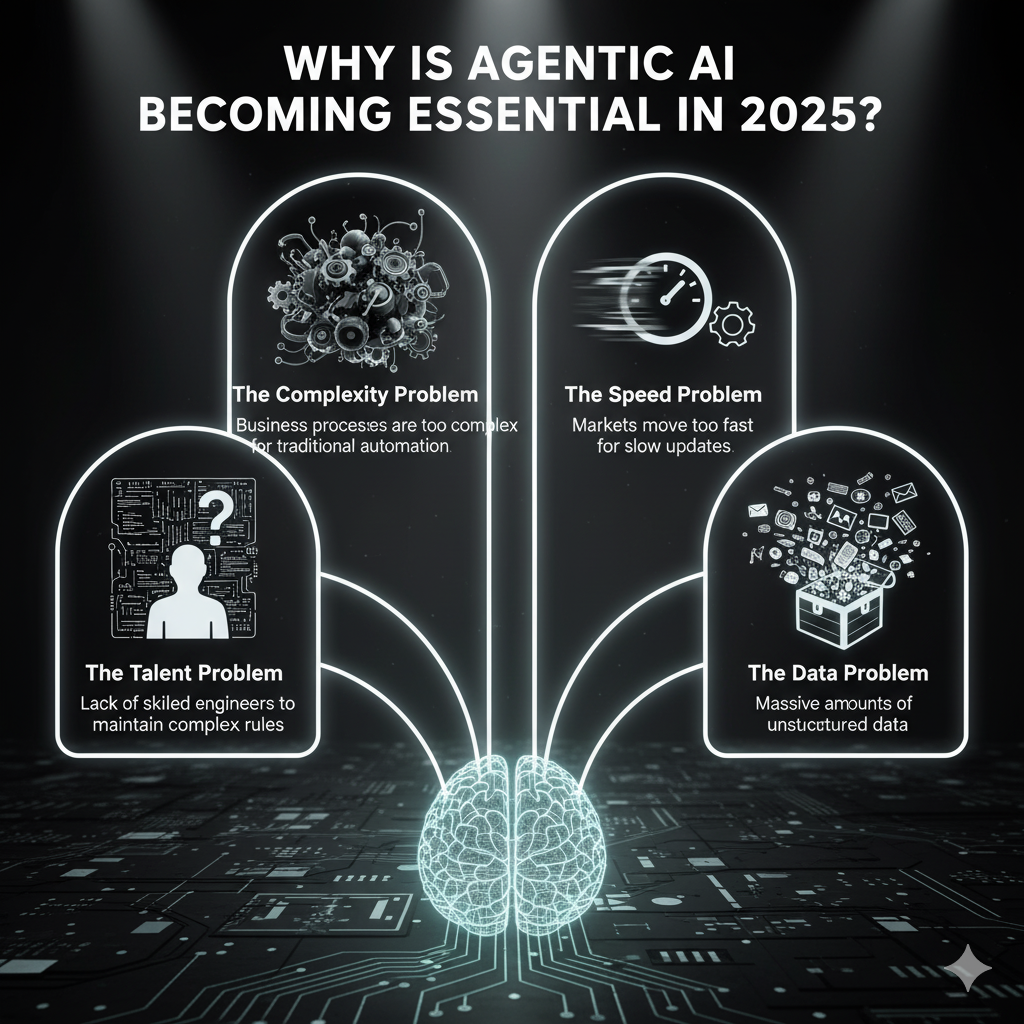
Business processes are getting more complex. More data sources, more integration points, more exceptions, more edge cases. Traditional automation can't keep up with this complexity.
McKinsey reports that AI agents can reduce review cycle times by 20-60% because they handle complexity that would require extensive manual work or impossible automation rules.
The Speed Problem
Markets move faster. Customer expectations change constantly. Competitors innovate quickly. You can't wait weeks for IT to reprogram automation every time something changes.
Agentic automation responds to change immediately. AI agents adapt in real-time rather than requiring development cycles for updates.
The Talent Problem
Finding people with the skills to build and maintain complex rule-based automation is expensive and difficult. Most companies don't have enough automation engineers.
Agentic AI reduces this dependency. You still need technical expertise for implementation, but ongoing operation requires less specialized programming knowledge.
The Data Problem
According to [Forrester Research], organizations using AI-powered automation report 50-75% increases in integration efficiency because AI agents handle the messy, unstructured data that breaks traditional systems.
Your business generates massive amounts of unstructured data, such as emails, documents, chat conversations, images, and videos. Traditional automation can't effectively process this.
Ready to Deploy AI Agents That Actually Work?
See how Agentic AI solves problems traditional automation can't. Get measurable ROI in 90 days.

What are Real-World Use Cases of Agentic AI?
Agentic AI isn't theoretical. Companies are deploying AI agents today for concrete business problems.
Customer Services Automation
AI agents handle complex customer inquiries that would break traditional chatbots. They understand customer intent, access multiple systems to gather information, make decisions about solutions, and even escalate appropriately to humans when needed.
Unlike rule-based automation that follows conversation scripts, Agentic AI systems adapt to each unique situation. They recognize frustrated customers and adjust their tone. They identify when a customer needs something that's not exactly what they asked for.
Sales and Lead Qualification
Autonomous AI agents engage prospects, qualify leads, schedule meetings, and even conduct initial discovery conversations. They don't just follow a script—they respond to prospect questions, provide relevant information, and assess genuine interest versus casual browsing.
They remember past interactions, understand what stage prospects are in the buying journey, and personalize outreach accordingly.
Data Integration and ETL
Agentic automation handles data integration between systems that change frequently. When API responses change format, AI agents adapt. When new data sources appear, they figure out how to incorporate them.
They detect data quality issues, resolve inconsistencies, and make intelligent decisions about how to handle ambiguous or incomplete data, all things traditional automation struggles with.
Financial Operations
AI agents process invoices, receipts, and expense reports even when formats vary wildly. They identify unusual transactions, flag potential fraud, and make routing decisions about approvals.
They adapt to new vendors, changing spending policies, and evolving compliance requirements without constant reprogramming.
IT Operations and DevOps
Agentic AI systems monitor infrastructure, detect anomalies, diagnose problems, and even implement fixes autonomously. They understand normal vs abnormal system behavior, investigate issues by gathering relevant logs and metrics, and take corrective action.
They don't just follow runbooks, they adapt troubleshooting approaches based on what they discover.
Content Moderation
AI agents review user-generated content, identifying policy violations even in novel situations not explicitly covered by rules. They understand context, recognize harmful intent, and make nuanced decisions about edge cases.
They adapt to new forms of problematic content without waiting for updated rulebooks.
When Should You Use Agentic AI vs Traditional Automation?
The Agentic AI vs traditional automation choice isn't either/or. Most businesses will use both, applying each where it fits best.
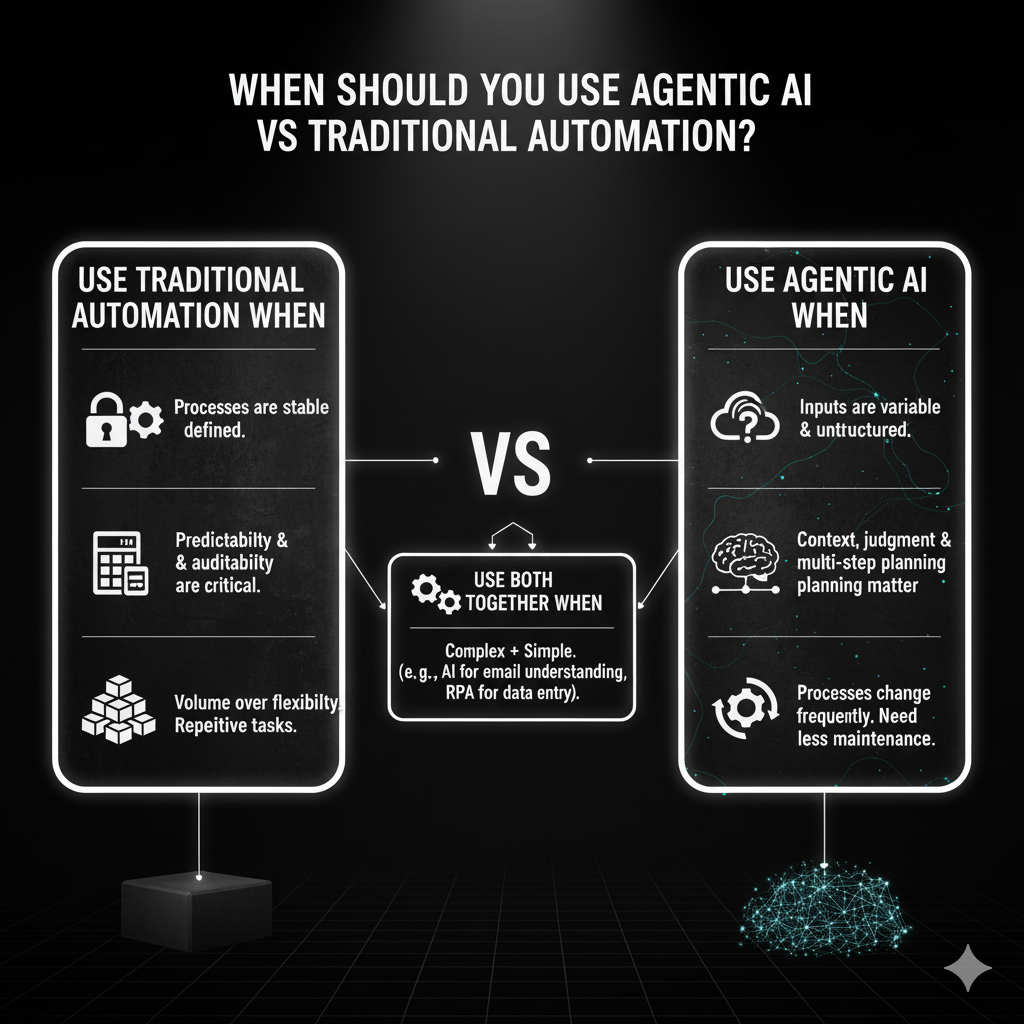
Use Traditional Automation When
Processes are stable and well-defined. If your workflow rarely changes and inputs are consistent, rule-based automation works great and costs less.
Predictability is critical. Financial calculations, compliance processes, and safety-critical systems need deterministic behavior that traditional automation provides.
Volume matters more than flexibility. Processing millions of simple, identical transactions? Traditional automation is faster and cheaper.
You need absolute auditability. When you must explain every decision with perfect clarity, explicit rules beat AI agent reasoning.
Resources are constrained. Traditional automation requires less computational power and ongoing cost.
Use Agentic AI When
Inputs are variable and unpredictable. Handling natural language, processing documents with varying formats, and dealing with unstructured data, Agentic AI shines here.
Context and judgment matter. Customer service, content moderation, and complex decision-making situations where rigid rules fail but human-like judgment helps.
Processes change frequently. If you're constantly updating automation rules to handle new scenarios, AI agents that adapt automatically provide better ROI.
Scale requires impossible rule complexity. When you'd need thousands of rules to cover all situations, Agentic automation that learns patterns is more practical.
You need multi-step planning. Complex workflows with dependencies, alternatives, and adaptation, AI agent handle orchestration better than predetermined sequences.
Use Both Together When
Many real scenarios benefit from combining approaches. Use AI agents for complex, variable parts of a process while traditional automation handles structured, deterministic steps.
For example, use Agentic AI to read and understand customer emails, decide appropriate responses, and route complex issues. Then use traditional automation to execute the database updates, send notifications, and update dashboards once decisions are made.
Stop Wasting Resources on Outdated Automation
Book your free AI strategy session. We'll show you where to use Agentic AI for maximum impact.

Conclusion
The difference between Agentic AI and traditional automation is fundamental, not incremental.
Traditional automation follows rules. Agentic AI pursues goals. Rule-based automation executes predetermined steps. AI agents adapt to situations. Traditional automation breaks when things change. Agentic automation adjusts.
Start small. Pick one high-value use case where Agentic automation can make a difference. Deploy it thoughtfully with proper oversight. Learn from the results. Then expand.
Ready to Implement Agentic AI in Your Business? We help companies implement Agentic AI solutions that deliver real business results. From strategy to deployment to ongoing optimization, we guide the entire journey.
Schedule a Free Consultation with an Expert!
FAQs
What is Agentic AI?
Agentic AI refers to artificial intelligence systems that autonomously make decisions, take actions, and pursue complex goals with limited supervision. Unlike traditional automation that follows predefined rules, AI agents understand objectives, evaluate situations, and adapt their behavior based on context and outcomes.
How is Agentic AI different from traditional automation?
Traditional automation follows explicit rules and predetermined sequences—if X, then Y. Agentic AI pursues goals autonomously, making decisions based on understanding the situation rather than following programmed instructions. AI agents adapt to change automatically, while rule-based automation breaks when conditions vary from expectations.
What are the main benefits of Agentic AI?
Agentic automation handles complex, variable tasks that break traditional automation. Benefits include adapting to change without reprogramming, processing unstructured data like emails and documents, making context-aware decisions, learning and improving over time, and reducing maintenance burden compared to rule-based systems.
When should I use traditional automation vs Agentic AI?
Use traditional automation for stable, predictable processes where consistency and auditability matter. Use Agentic AI for variable inputs, complex decision-making, frequently changing processes, unstructured data handling, and situations requiring contextual judgment. Many businesses use both together strategically.

